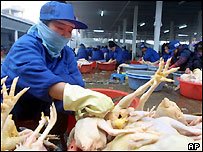
Date: Sun 16 Jul 2006
Indonesia: Suspected (42nd) Death from H5N1 Avian Influenza
-----------------------------------------------
A 44-year-old Indonesian who died 4 days ago has tested positive for bird
flu, a senior Health Ministry official said on Sunday [16 Jul 2006], citing
a local test. If the diagnosis is confirmed by a laboratory sanctioned by
the World Health Organization (WHO), the East Jakarta man would be the 42nd
bird flu death in Indonesia, a sprawling archipelago where the virus has
killed millions of fowl and caused more human deaths this year [2006] than
in any other country. Confirmation would take Indonesia level with Viet Nam
as the country recording the most human fatalities from the H5N1 strain of
the avian flu virus. Viet Nam's 42nd death occurred in 2005. "Like so many
other bird flu cases, the man had contact with a dead chicken in his
neighborhood. He died on 12 Jul 2006, and we are now waiting for the
confirmation," I Nyoman Kandun, director general of communicable disease
control at the Health Ministry, told Reuters.
According to the WHO, the H5N1 strain has killed 132 people across the
globe since 2003. The global health arm has so far confirmed 41 deaths in
Indonesia, where the virus is endemic in poultry in nearly all of the
country's 33 provinces. Earlier this month [July 2006], a senior government
official said Indonesia's poultry death rate from bird flu was worsening,
possibly due to poor vaccination coverage. In 2005, [poultry] deaths for
the year as a whole were 1.2 million.
Indonesia has been criticized for doing too little to stamp out the H5N1
virus, which remains essentially an animal disease but which experts fear
could spark a pandemic if it mutates into a form easily transmissible
between humans. The government has so far shied away from mass poultry
culling, citing lack of funds and the impracticality of the move in a
country with millions of backyard fowl. Vaccination is the preferred method
to prevent the spread of bird flu among poultry.
Indonesia drew international attention in May 2006 when the virus killed 7
members of a single family in North Sumatra. Experts said there could have
been limited human-to-human transmission in the cluster case. On Thu [13
Jul 2006], the leading science journal Nature reported that multiple
mutations had been found in the H5N1 virus that killed the Sumatra family,
although scientists are unsure of their significance [see: Avian influenza,
human (95): China, Indonesia 20060713.1934].
[Byline: Achmad Sukarsono]
--



0 Comments:
Post a Comment
Subscribe to Post Comments [Atom]
<< Home